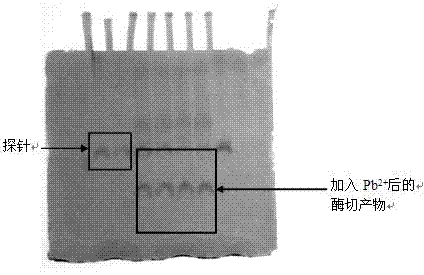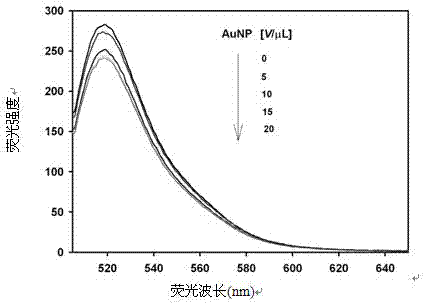Lead ion fluorescent DNA (Deoxyribose Nucleic Acid) probe and fluorescent determination method for lead ion concentration
A DNA probe, lead ion technology, used in recombinant DNA technology, DNA/RNA fragments, etc., can solve the problems of multiple labeling of DNA probes, high requirements for experimental conditions, and many difficulties in operation, and achieves good specificity and avoidance. High fluorescence background, good selectivity
- Summary
- Abstract
- Description
- Claims
- Application Information
AI Technical Summary
Problems solved by technology
Method used
Image
Examples
Embodiment 1
[0047] Adopt conventional gel electrophoresis experiment method, the feasibility of lead ion fluorescent DNA probe test lead ion method of the present invention is evaluated, experimental result is as follows figure 2 The gel chromatogram electrophoresis is shown. The first and second lanes from the left are the bands of lead ion fluorescent DNA probes, which become lighter and disappear after the addition of lead ions, and the electrophoretic bands that appear in new positions in the third to sixth lanes represent the bands after the addition of lead ions enzyme cleavage products. The addition of lead ions is caused by figure 2 The only reason for the change of the bands shown is that the lead ion fluorescent DNA probe and method of the present invention are suitable for the detection of lead ions.
[0048] In order to determine the optimal addition amount of nano-gold colloid, a sufficient concentration of lead ion solution was added to multiple DNA probe solutions, and ...
Embodiment 2
[0060] Embodiment 2: the mensuration of soluble lead ion in toy sample
[0061] Reference standard: EN71-3:1994+A1:2001
[0062] This embodiment shows the situation when the sample to be tested is a toy, and all accessible parts on the toy sample are tested.
[0063] 1. Sample preparation
[0064] For toys such as textile fabrics, plastic or rubber, use scissors or pliers to cut the material into small pieces of 5mm×5mm as the samples to be tested.
[0065] For toys with paint, ink or similar coatings, use a clean razor blade to scrape off the part as the sample to be tested.
[0066]For toys that are liquid paint or ink, take a part of the paint and apply it on a clean glass plate, let it dry naturally at room temperature, and then scrape it off as the sample to be tested. If the sample to be tested cannot be dried at room temperature, it should be dried in an oven according to the temperature used, and scraped off to obtain the sample to be tested.
[0067] All powdery...
Embodiment 3
[0075] Embodiment 3: Determination of total lead content in the plastic sample
[0076] 1. Pretreatment of samples before testing
[0077] Crush the plastic sample, weigh 0.5g, accurate to 0.1mg, put it into the digestion tank, add 7mLHNO 3 and 1.5mLH 2 o 2 . Close the digestion tank and place it in a microwave digestion system for digestion. The heating program is shown in Table 1 below (reference instrument, Anton Paar Microwave 3000).
[0078]
[0079] The resulting digestion solution was slightly heated on the electric heating plate to drive the acid to about 1mL, then add ultrapure water, and dilute to about 50mL. To measure the acidity of the solution, if the pH value is greater than 7, use 1 mol / L NaOH to neutralize to pH 7.0, and perform fluorescence measurement in Tris-HCl buffer.
[0080] 2. Determination
[0081] Add 20 μL of the sample to be tested in 50 mmol / L Tris-HCl (pH 7.0, 50 mM NaCl) buffer solution containing lead ion fluorescent DNA probe, mix ...
PUM
| Property | Measurement | Unit |
|---|---|---|
| fluorescence | aaaaa | aaaaa |
| fluorescence | aaaaa | aaaaa |
Abstract
Description
Claims
Application Information
 Login to View More
Login to View More - R&D
- Intellectual Property
- Life Sciences
- Materials
- Tech Scout
- Unparalleled Data Quality
- Higher Quality Content
- 60% Fewer Hallucinations
Browse by: Latest US Patents, China's latest patents, Technical Efficacy Thesaurus, Application Domain, Technology Topic, Popular Technical Reports.
© 2025 PatSnap. All rights reserved.Legal|Privacy policy|Modern Slavery Act Transparency Statement|Sitemap|About US| Contact US: help@patsnap.com



